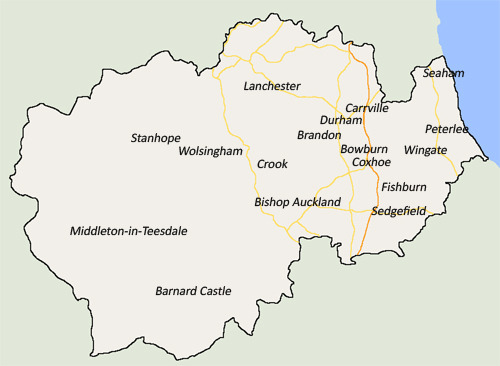County Durham
Map of the County Durham Area

County Council
- Durham County Council
- County Hall Durham County Durham DH1 5UL
- http://www.durham.gov.uk/
County Durham
County Durham in North East England has occupied a strategically important position for settlers over the centuries, from the Romans and the Angles to the Saxons and the Normans. Durham's county council was established in 1888, along with similar councils across England and Wales. A traditional centre for mining and agriculture, the county has recently seen extensive regeneration and a focus on hi-tech industries and tourism.
According to the 2011 Census, approximately 513,200 people live in County Durham. Covering an area of 862 square miles or 2,230 square kilometres, Durham is the county's only city and is the site of a majestic Norman cathedral, an 11th century castle and the University of Durham. Major towns include Barnard Castle, Bishop Auckland, Chester-le-Street, Consett, Newton Aycliffe, Peterlee, Spennymoor and Sheldon. While a borough of its own since 1997, Darlington is the largest settlement in the ceremonial county of Durham.
With the founding of Durham Cathedral in 1093, the region of Northumbria became one of Britain's epicentres of Christianity. William the Conqueror gave the Bishops of Durham secular and spiritual control over the modern County Durham following the Norman Conquests. Having also powers over Cleveland and Tyne and Wear, the Prince Bishops have control over taxes, currency, armies and the courts. It was only in 1536 that their powers were reduced significantly by Henry VIII. The Bishops' mark on the county remains with beautiful architectural wonders, including Auckland Castle.
County Durham features a wealth of natural and cultural heritage. The county is home to the scenic Durham Dales, Hamsterley Forest, Barnard Castle, the Binchester Roman Fort, and Finchale Priory. Situated in Durham City, Durham Cathedral and Castle are recognised as a UNESCO World Heritage Site. The 11th century Durham Cathedral also served as the setting for the Hogwarts School of Witchcraft and Wizardry in the Harry Potter films. The county's railway heritage is also well represented with a number of historic sites, including the Tanfield Railway and Weardale Railway. County Durham is also home of the University of Durham, England's third oldest university.
Industry transformed County Durham, which became an important economic centre in the 18th and 19th centuries. The first passenger steam railway began operating between Stockton and Darlington in 1825, a testament of the county's status as a world leader during the Industrial Revolution. Coal and iron production were once main economic activities in County Durham, while more recently hi-tech businesses have helped diversity the county's economy. Other industries with a strong presence in Durham include telecommunications, electronics, biotechnology and pharmaceuticals. Tourism and agriculture also remain important sectors.
Transport
- Durham City Transport
- http://www.durhamcitytransport.com/
Banks and Building Societies
- The Investing site allows you to search for your local bank branch's location, opening hours and contact details in County Durham.
- http://www.theinvestingsite.com/banks/county-durham
Media and Newspapers
- Durham Times
- http://www.durhamtimes.co.uk/
- Norwich Evening News
- http://www.eveningnews24.co.uk/
Tourism - Official Site
- This is Durham
- http://www.thisisdurham.com/
Museum
- Durham Museum
- http://www.durhammuseum.org/
University
- Durham University
- The Palatine Centre Durham University Stockton Road Durham DH1 3LE
- https://www.dur.ac.uk/

 Animal Welfare
Animal Welfare